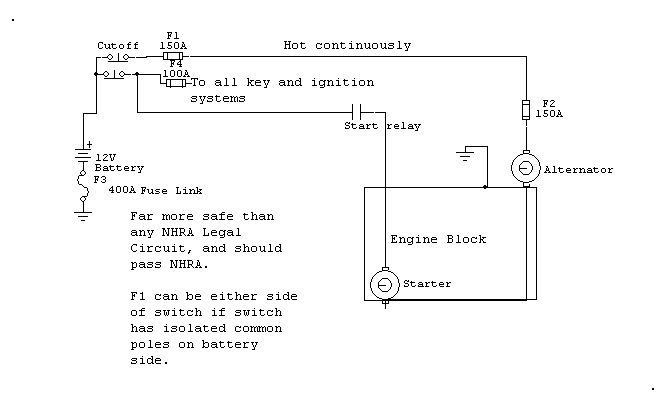I used this for my battery post up front.
JEGS Performance Products 10315, JEGS Remote Battery Jumper Terminals | JEGS Performance Products
I built a mount off the firewall for it. I bought a negative one and then thought it was actually kind of pointless since you can use the frame or nut on suspension so never installed it.
I used this battery box since it met NHRA requirements
http://www.summitracing.com/int/parts/tay-48100/overview/
The problem where I live is cold weather and I could see it pulling 200 amps when it's cold.
http://www.linnbenton.edu/auto/fall/electric/start_test.pdf With a 4 gauge or even 2 gauge wire over 12-15 feet would be over 1 volt loss. Much more than stock. I went with 1/0 for starter which keeps it closer to the stock voltage losses.
The way mine is hooked up will provide good fire safety at the track and protection from surges. A much better overview on various ways to hook up remote mount battery and NHRA accepted vs. better than NHRA with having to use cut-off is already on this site
Safe Battery Installation Guidelines
Excerpts of his general rules -
All systems are slightly different, but here are general rules:
1.) Route the wires safely. Do not run any electrical wires where they can chaff or rub against things, be easily cut or damaged, and against fuel or brake lines.
2.) Never run high current leads through flammable materials or inside vehicle passenger compartments. The exception to this is if the cable meets proper safety specifications for flammability, thermal, and insulation ruggedness. The cable should generally be protected or armored inside the car, or where it might contact damaged in an accident.
3.) Always use the appropriate fuses, fuse links, or circuit breakers on SOURCE ends of wires as close to the source as possible. The proper size protection is always based on maximum current draw in normal conditions, assuming the wire is properly sized. There are two sources. The alternator is a source, the battery is a source.
4.) DO NOT size protection based on wire current rating for the wire type and gauge, unless wire gauge is running right at load current maximum (which is unsafe anyway).
5.) Fuse ratings are not hard limits. A typical 100-ampere fuse takes up to 120 seconds to blow at 200% overload, but can also fatigue or blow at less than actual fuse rating if in a hot environment, if the holder contacts are loose or dirty, or if has been subject to short overloads.
6.) A fuse, switch, or breaker should never be placed so the battery can be removed accidentally while the alternator is running. This, like any loss of battery connection on a running engine, can spike the electrical system and ruin your expensive electronics.
7.) Fuses and breakers can not be paralleled to reliably increase rating. If you parallel connect a fuse or breaker, it does NOT necessarily double the rating. This is because a fuse or breaker will not have the same exact resistance of another identical part, so current will probably not divide equally between them. This isn't harmful, it just means the system might be fused lighter than you assume it is fused.
8.) Fuse links are most reliable to prevent false failures if very high current, but are only for fire protection. Bolted fuses, like marine fuses, are most reliable high current at lower currents.
9.) For a ground wire longer than ~4 feet, the chassis of a vehicle generally has much less resistance than any size copper you can run. The only possible problem is getting a solid connection to the chassis.
10.) The block of a vehicle has far less resistance than any copper you can run.
11.) In order of engine ground effectiveness, it is block, heads, bell housing, and timing cover. All are OK. The intake is a bad ground point.
12.) The frames and sub frames are good ground points, if properly attached. The firewall is a good ground point, as is any body welded panel, if a good connection is made.
Actual excerpts from NHRA below- the master cutoff thing I'm not sold on... I bought one but didn't actually install it since it would be dumb and unsafe for daily driving. I have provisions in cable length to add in temporarily if the tech decides to make it a requirement at the track.
http://www.nhra.com/UserFiles/file/General_Regulations.pdf
8:1 BATTERIES
All batteries must be securely mounted; must be of sufficient
capacity to start vehicle at any time. Batteries may not be relocated
into the driver or passenger compartments. Rear firewall of .024-
inch steel or .032-inch aluminum (including package tray) required
when battery is relocated in trunk. In lieu of rear firewall, battery
may be located in a sealed .024-inch steel, .032-inch aluminum, or
NHRA-accepted poly box. If sealed box is used in lieu of rear
firewall, box may not be used to secure battery and must be vented
outside of body. Relocated battery(s) must be fastened to frame or
frame structure with a minimum of two 3/8-inch-diameter bolts.
OEM located batteries without complete OEM hold-down hardware
must be secured to OEM battery box/tray using the same 3/8-inchdiameter
bolt hold-down method described in previous sentence.
(“J” hooks prohibited or must have open end welded shut.) Metal
battery hold-down straps mandatory. Strapping tape prohibited. A
maximum of two automobile batteries, or 150 pounds combined
maximum weight (unless otherwise specified in Class
Requirements), is permitted. Maximums may vary according to
Class Requirements.
8:4 MASTER CUTOFF
Mandatory when battery is relocated, or as outlined in Class
Requirements. An electrical power cutoff switch (one only) must be
installed on the rearmost part of each vehicle and be easily
accessible from outside the car body. This cutoff switch must be
connected to the positive side of the electrical system and must
stop all electrical functions including magneto ignition. The off
position must be clearly indicated with the word “OFF.” If switch is
“push/pull” type, “push” must be the action for shutting off the
electrical system, “pull” to turn it on. Any rods or cables used to
activate the switch must be minimum 1/8-inch diameter. Plastic or
keyed switches prohibited. Switches and/or controls must be
located behind rear wheels on rear-engine dragsters.











